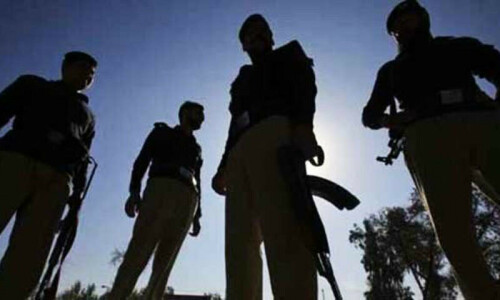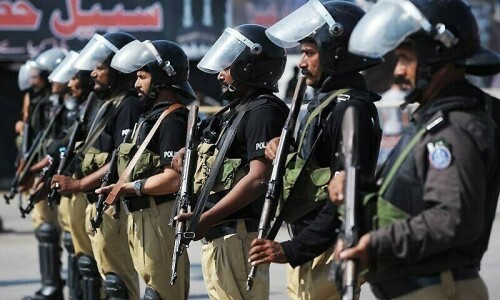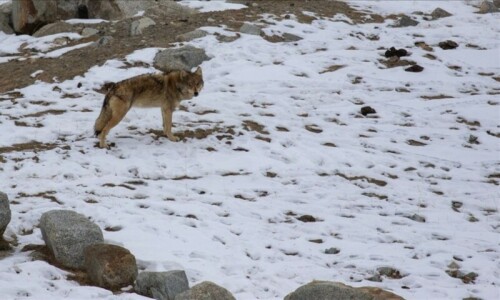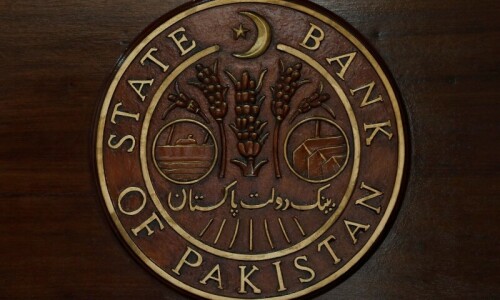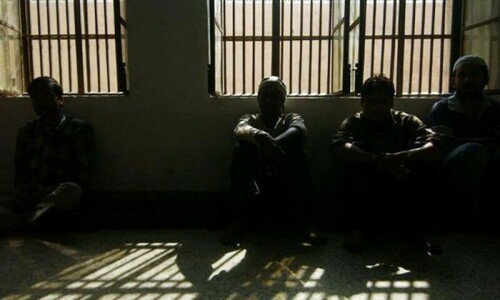Karachi is not a tourist city anymore. Its streets today are not filled with tourists; there are no hop-on-hop-off buses running its length. The facades of the famous buildings are not lit up at night.
Nonetheless, the city is bustling with economic activity. There is a boom in construction, with malls and skyscrapers being built overnight. These buildings are connected with newly built underpasses and flyovers, which are instantly packed with new vehicles.
But, no new trees are being planted.
And it seems construction companies are filling the void by decorating underpasses with tiles painted with lush green scenery on them.
Political parties have their posters placed in every nook and cranny, but there is hardly any pride left to be claimed. The Karachi of today reminds me of the goose which laid golden eggs but its owner, in his greed, slaughtered it to steal all its eggs right away.
The streets are flooded with people, but there are hardly any public spaces. There are fragments of aesthetically inspiring architecture, but it is not celebrated anymore.
Somewhere in the pursuit of happiness, we have forgotten to take a pause and appreciate the city’s decaying heritage.
I still get odd requests for a guided tour, most of which I am unable to oblige. However, I insist that people explore the city on their own. I tell them to walk down its smog-filled alleys in the old city without a purpose and see the people connect with its ancient mansions and patios. These forgotten landmarks have stories to tell.
And so, I've put together a Do-it-Yourself guide for a day’s tour to some of the city’s easily accessible places. Set out on a Sunday morning to avoid traffic. Also, take some music with you – famous titles by Marvin Gaye, Melaine Safka, Geeta Dutt and Farida Khanum; they will help you make sense of the city better.
1. Freemasons Lodge
The first Freemason lodge in the Indian subcontinent was built in Calcutta at the turn of the 17th century. The lodges in Karachi and Lahore were built later at the start of 20th century as part of a plan to expand the fraternity.
The secrecy surrounding the brotherhood resulted in speculation about their activities even in the earlier days – perhaps the reason the building was called ‘Jaadu Ghar’.
Freemasonry was banned in Pakistan during 1972, and the lodges in Karachi and Lahore were nationalised. The lodge in Karachi was later handed over to the WWF, and apparently, there are plans to turn it into a wildlife museum.
Located on the Din Mohammad Wafai Road, the Freemasons Lodge in Karachi is a beautiful edifice with large windows and a stunning wooden staircase at the entrance. Inside the building, close to the staircase, you'll be welcomed by old plaques and the brotherhood’s symbols.


On a casual Sunday, you may run into the old caretaker of the building, who lives in a tiny house inside the compound. He strongly rejects the idea that the brotherhood engaged in vile rituals. According to him, it was just another social forum and the members gathered there every evening for dinner.
2. Hindu Gymkhana
Continue your journey on the same road and make the next stop at Hindu Gymkhana. Built in 1925, the structure still retains it majestic look. The building was handed over to the National Academy of Performing Arts (Napa) in 2005 and has since been transformed into a fine institution for performing arts.
With the help of a newly built auditorium, Napa has brought the building back into public sphere, and is using it to offer some much-needed art and entertainment to the public.


The original structure was built as a recreation centre for Hindu elites in the city. It was designed by Agha Ahmed Hussain and was named after Ramgopal Gourdhanandh Mohatta who contributed generously for its construction.
3. Burns Garden – Sobhraj Chatumal Terrace and National Museum
Make your next stop in front of the National Museum. The sad state of the museum has put it out of favour with public attention, even though there is a dearth of good museums in the city. The place barely receives visitors even on a national holiday, when the museum arranges special exhibits for events like Independence Day, etc.
Burns Garden, in which the building is located, still has some age old trees which could be a source of delight in an area deprived of greenery. The compound also has a rarely visited but delightfully built terrace – the Sobhraj Chatumal Terrace.



This terrace was built in 1927, way before the current building of the museum was built. Presumably, the terrace could be accessed separately from both ends of the garden, but it has been closed now. It was built in honour of businessman and philanthropist Sobhraj Chetumal, who had also built a dispensary and a maternity home in memory of his wife, Kishan Devi Sobhraj.
The park’s layout is unlike what I have seen elsewhere and fortunately, the renovation has not affected its original design, except for the original stone being replaced with cement blocks that have not been painted as yet.
It was originally meant to be a women’s park, but all you'd see here today are some children playing cricket.
4. DJ Science College and the principal’s bungalow
Leave your car in the museum’s parking lot and walk across the street to the DJ Science College. One of the most iconic buildings of the era, it is a reminder that the elites of yore were not detached from the masses and gave back to the city as much as they received from it.
The college was inaugurated on January 19, 1887, by Lord Reay, the Governor of Bombay, in a makeshift building before the present building’s foundation stone was laid by the Viceroy of India, Lord Dufferin, on November 19, 1887. It was built in neoclassical style and considered to be the finest work of James Strachan.
Try to negotiate with the caretaker and climb the staircase to one of the side towers. The view from the top is enchanting.


The DJ Science College had other buildings built as part of its compound. There is an elegant bunglow opposite the street, where the principal lives. With some luck, you could walk inside and see the glorious structure which is fit for a king.
The building has been renovated very well. The close-by Mitharam hostel was used for accommodating the out-of-town students of DJ Science and NED campuses, but sadly now, it is off-limits to public after it had been handed over to the Rangers.




Someone once told me that there was a statue of Mitharam placed in the centre portico of DJ Science College, which was taken to the first floor and thrown out by students some time ago.
5. Botal Gali
Continue driving towards Pakistan Chowk. On your left, you will find Botal Gali, which is popular for its unique assortment of secondhand bottles and an increasingly diverse perfume collection. Walk from one end to another. You will find some old stone structures tucked between newly constructed flats.


6. Sevakunj Hostel and Aram Bagh
Turn right from Pakistan Chowk and keep walking leisurely, appreciating the craftsmanship on the buildings on either side of the road. This area, in particular, has stunningly crafted balconies. Right before Aram Bagh, you will see the Sevakunj Hostel building on your right hand.
The building is constructed in block fashion and has wide galleries. There are printing shops on the ground floor and you can negotiate with one of the shopkeepers to access the inside. The view from the central courtyard is fascinating. You will be able to see deserted balconies and rooms from the courtyard. In these very rooms, many foreign students stayed during their time at the NED University.





Make a brief stop at Aram Bagh, which was an important area for Hindu pilgrims before the Partition. According to one legend, Ram and Sita made a brief stop here on their journey to the Hinglaj yatra. So understandably, they built a number of temples here, which gave way to new construction over time.
7. Kabootar Chowk
Drive straight ahead on Burns Road, cruising past all the eateries. Turn right from the crossroad and make a stop at Kabootar Chowk in front of Sindh High Court. You will find a few hawkers selling corn seeds to visitors.

Buy some corn and walk towards the chowk. Here, once stood Mahatama Gandhi’s statue, which was handed over to Rustam Cowasjee after the Partition, who later gifted it to the Indian Embassy in Islamabad. The place is popular with families and on a Sunday, you will see lots of people sitting here idly and throwing corn to the pigeons.
Engage in the ritual. It could be therapeutic.
8. Gul Bai Maternity Home
Gul Bai Maternity home was built by Jamshed Nasserwanjee, the founder of modern day Karachi, in honour of her mother.
The place is reminiscent of the good old Karachi; a big courtyard, an impressive facade, and gracious neem trees. The maternity home here has been abandoned for some reason now, but it still retains its royal look. The first thing to catch your eye is a beautiful fountain in the middle. There is a plaque installed inside it, on which some one has thrown blue paint.





The building is locked up, but you can have a look through the glass windows into the building. Some basic furniture is still lying inside. Someone once told me that the place is used for shooting commercials and could be rented.
9. Richmond Crawford Veterinary Hospital
In the Karachi of yore, the welfare of animals was a big concern as well. The Richmond Crawford Veterinary Hospital on M.A. Jinnah road is evidence of the fact. It was named after Richmond Crawford, commissioner of Sindh in 1840s, who was known for his efforts for the welfare of animals.
The place had been associated with Society for the Prevention of Cruelty to Animals (SCBA), which was founded in 1880 by eminent Karachiites such as Khan Bahadur Hassanally, Beg Effendi. Sayed Hassan Mediru, Tance Denso and Mr Framroze. The society helped raise awareness of animal welfare among citizens and played a pivotal role in the enforcement of laws protecting animal rights.



The building is rather humble but possesses the characteristic elegance of the bygone era. It has been repainted, and flashy tiles have been put in, affecting its authentic look. Thankfully, the hospital is still functional and resident doctors continue to treat animals which are brought from nearby areas.
10. Khaliq Deena Hall
Khaliq Deena Hall has to be one of the most beautiful buildings on M.A. Jinnah road. With its high podium, tall pillars and Grecian-style pediment, it catches your eye from a distance.
It was named in honour of Ghulam Hussain Khaliq Deena, a Khoja businessman and philanthropist, who contributed generously for the construction of the building as a public hall and library.
The library is rather modest, but the hall is still used for hosting religious and cultural events. The hall is historically significant as a symbol of resistance against the British rule. It is where the Trial of Sedition took place in which the British government indicted Maulana Mohammad Ali Jauhar for mutiny as an aftermath of the civil disobedience movement, for saving the Turkish Khilafat.



11. Merewether Tower and Wazir Mansion
Drive to the end of Bunder Road and make a brief stop at Merewether Tower. It was designed by James Strachan and built between 1884 and 1892 in honour of Sir William L. Merewether, Commissioner of Sindh from 1867 to 1877. The larger bell at the top was designed to announce the hour mark, while the smaller bells rang at each quarter.
The impact of pollution on the edifice is visible. Dirt is stuck between the elegantly crafted motifs. Someone painted one side of the wall with anti-Israel graffiti, possibly the reason why the gatekeeper is hesitant to let anyone inside.

Leave your car there and enter the narrow streets of Kharadar, where the Wazir Mansion is located. Look for Barkati Street (formerly Chaghla Street). Ask people for directions to Wazir Mansion. Get lost for a bit in the maze of streets. The buildings here are one of the oldest in the city. With some trial and error, you should be able to reach Wazir Mansion in 15 minutes.



Jinnah Poonja, Mohammad Ali Jinnah’s father, rented a two-room apartment in this building when he migrated to Karachi in 1874. M.A. Jinnah, his eldest son was born here in 1876. Jinnah stayed in this very building until 1892, when he left for London to pursue higher studies. The building was named after a later resident who purchased it at the turn of the century.


12. Flagstaff House
One of the earlier buildings designed by Moses Somake, Flagstaff house is a beauty to behold. One of the few well-maintained edifices of stone masonry in the city, a visit to Flagstaff is a must for any tourist. The building has well-curated front and back lawns. It is accessible from Avari Towers via Fatima Bonus Road.
The house was built in 1890. Mr Jinnah purchased it in 1944 from the Kartak Family. Although Jinnah spent only a few days in this house, Miss Fatima Jinnah lived here from 1948 to 1964.
The building was restored and declared a museum in 1985. You will find Jinnah’s personal belongings inside the house, which were brought from his house in Mumbai.


There is still much more to the city and this DIY tour should only serve as a start.
When you embark on this journey, you will discover that your experience will be different from mine. Your Karachi will be different from everyone else’s. Only then will you understand the folly of generalising a statement about this city of more than 20 million people.
Long live Karachi!
This piece was originally published on October 20, 2015

















